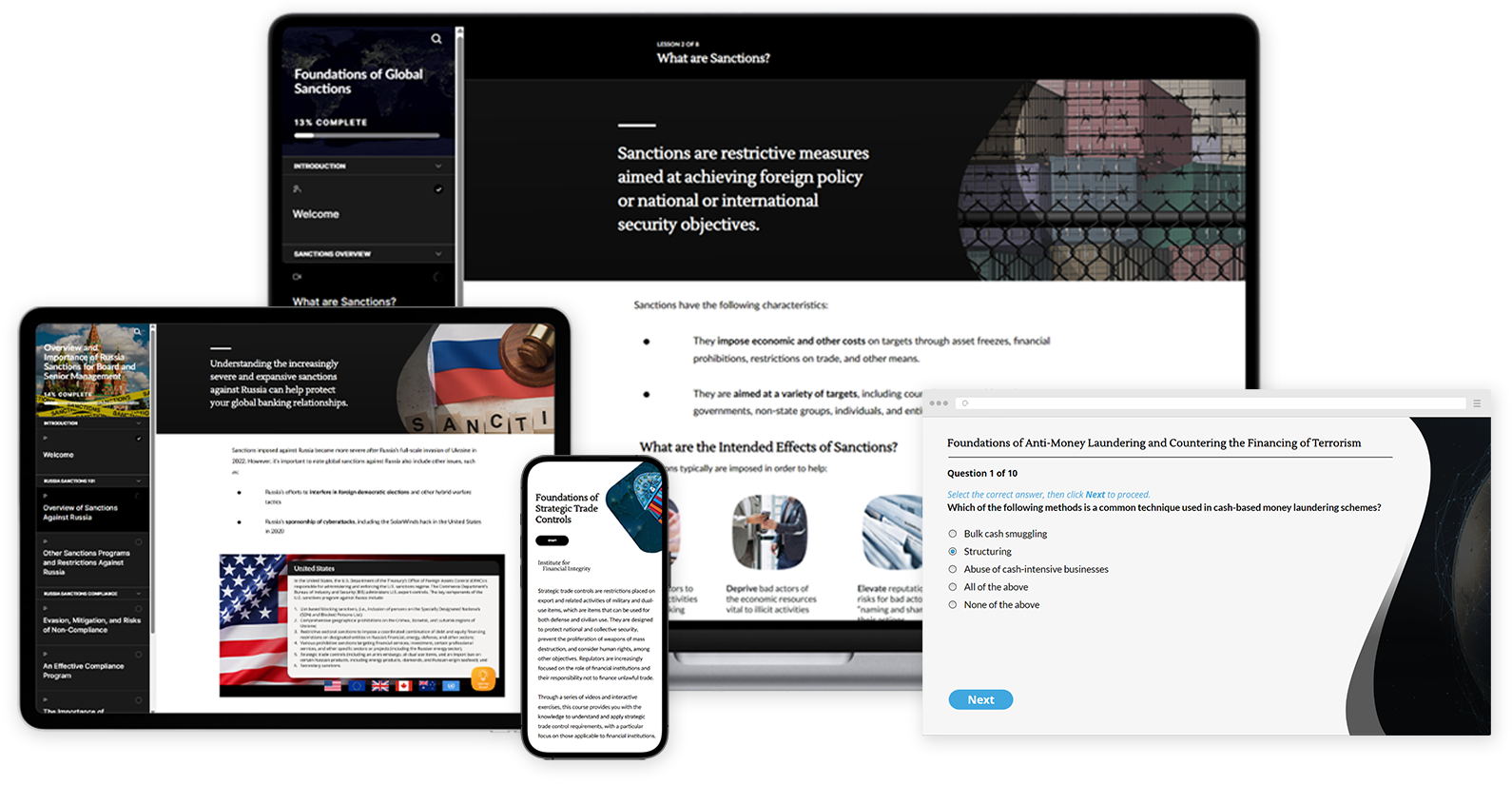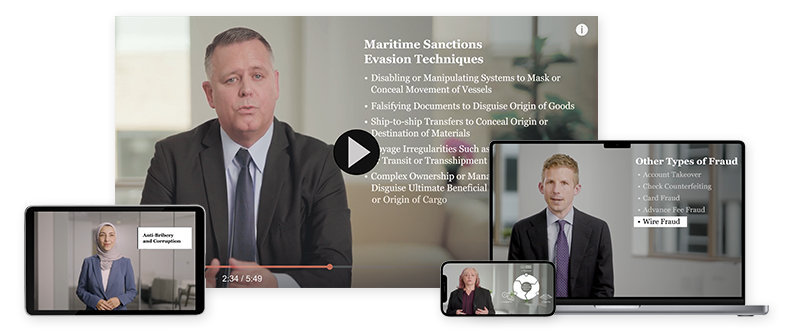Why Compliance Training Still Fails
The Cost of a Check-the-Box Culture
📅 May 15, 2025
📅 May 15, 2025
In late 2024, headlines lit up with news of a $3 billion fine slapped on one of North America’s largest banks. The cause? Years of anti-money laundering failures that let illicit funds slip through the cracks. What made it even more alarming was this: employees had technically done everything right—on paper, as they must have completed the mandatory compliance training. The boxes were checked, the certificates filed. But clearly, something critical was missing.
Unfortunately, this story is all too familiar. Many institutions have robust training programs in place—at least in theory. Staff watch the videos, take the quizzes, and click “complete.” But when compliance becomes just another task to get through, the real goal—changing behavior and actually reducing risk—gets lost in the shuffle.
The truth is, traditional compliance training often focuses more on proving that training happened than on making sure it works. And that “check-the-box” mentality leaves organizations vulnerable—to costly mistakes, regulatory enforcement actions, and reputational damage.
U.S. Department of Justice Press Release (October 11, 2024)
“For nearly a decade, TD Bank failed to update its anti-money laundering compliance program to address known risks. As bank employees acknowledged in internal communications, these failures made the bank an ‘easy target’ for the bad guys.”
⚠️ Regulators aren’t satisfied with training that exists on paper. They want to see programs that shape behavior, reduce risk, and evolve with emerging threats.
In this article, we’re digging into why compliance training still fails, even in well-intentioned institutions. We’ll look at what’s broken, what it’s costing us, and how a smarter, more strategic approach can turn training into a true line of defense—rather than a missed opportunity.
So what exactly is a “check-the-box” approach to compliance training?
At its core, it’s when the primary goal of training shifts from learning to simply proving that training occurred. It’s the kind of training program where success is measured by completion rates and attendance logs—not by how well employees understand the material, let alone how they apply it in their day-to-day roles.
You’ve probably seen the signs:
So why does this happen?
In many cases, it comes down to pressure—pressure to show auditors and regulators that training has been completed; pressure to roll out training at scale with limited resources; and pressure to do it quickly. Without strong internal champions pushing for strategic learning, the easiest route becomes the default: launch the same cookie-cutter content to everyone, check the completion box, and call it a day.
But that approach misses the point. In today’s dynamic risk environment—where threats evolve quickly and regulators are increasingly scrutinizing the quality of compliance programs—a box-ticking culture won’t cut it. If training doesn’t resonate, risks don’t get flagged. And when risks go unnoticed, institutions pay the price.
Let’s be honest—most people don’t walk away from a compliance training session feeling inspired or better equipped to manage risk. And it’s not because they don’t care. It’s because the training isn’t always built to help them succeed in the real world.
Here’s why so many traditional training programs fall flat:
If you’ve ever sat through a training and thought, “This has nothing to do with my job,” you’re not alone. A major issue with many compliance programs is that they treat everyone the same. Whether you’re a customer service rep in a retail branch or managing cross-border payments in a trade finance unit, you might get the exact same content—when in reality, the risks you face and the decisions you make are completely different. Without real-world examples that match the challenges staff encounter, the training just doesn’t stick.
Even when the information is useful, the way it’s delivered often gets in the way. Think long, text-heavy modules, monotone voiceovers, or walls of legal definitions. People zone out. They click through. And a week later, they’ve forgotten most of it. That’s not a learner problem—that’s a design problem. Without repetition, real-life scenarios, or interactive moments to break things up, retention is minimal.
For many institutions, success is measured by how many people completed the training. But checking a box doesn’t mean someone actually learned anything—or that they’ll apply it when it counts. There’s rarely follow-up to see if people can recognize a suspicious transaction six months later, or if that new sanctions update changed how teams operate. Without measuring comprehension or behavior change, it’s impossible to know whether the training is actually reducing risk.
Risk changes fast—especially in the financial sector. But training often lags behind. Institutions roll out annual modules that don’t reflect current threats, emerging technologies, or regulatory focus areas. For example, while regulators are turning their attention to digital asset risks and AI-driven fraud, many programs are still running the same fraud or AML training from years ago. When training doesn’t reflect what’s actually happening in the risk environment, it becomes performative—just another thing to get through before moving on to “real” work.
When compliance training is treated as a formality, the consequences aren’t just theoretical—they’re very real, and very costly.
It’s one thing for an employee to complete a training module. It’s another for them to apply what they’ve learned when it matters. We’ve seen time and again how staff who’ve technically fulfilled all their training obligations still fail to follow basic procedures—allowing high-risk transactions to go unreported, missing red flags in KYC files, or failing to escalate suspicious activity. The problem isn’t that they didn’t take the training—it’s that the training didn’t stick.
Regulators aren’t just checking whether training happened. Increasingly, they’re asking how effective it was. In several recent enforcement actions—such as the $3 billion penalty against TD Bank in 2024 and earlier actions against institutions like HSBC and Standard Chartered—deficiencies in staff training were explicitly cited. The message is clear: if your program is superficial or out of sync with current risks, it can be used against you in an investigation.
Poorly designed training doesn’t just fail to educate—it erodes trust. Employees come to view compliance as a box-ticking exercise, not a real business risk. This leads to training fatigue, eye-rolling during mandatory modules, and a general sense of disengagement. And when compliance doesn’t feel meaningful internally, it’s far less likely to be taken seriously in practice.
Once your institution’s name is tied to a major compliance failure, everything changes. Regulators look more closely at your entire program. Clients—especially institutional ones—may begin to question your internal controls. Media scrutiny adds fuel to the fire. And even after the fine is paid, that reputational hit lingers, complicating relationships with investors, partners, and stakeholders.
The truth is, compliance training that merely checks the box isn’t just ineffective—it’s risky. It creates blind spots, undermines your culture, and leaves your institution exposed to exactly the types of failures training is meant to prevent.
As the regulatory space evolves and risks become more complex, it’s not enough to say training happened. Financial institutions need programs that actually work—ones that engage, educate, and empower employees to recognize and respond to real-world threats.
In our upcoming article, Rethinking Compliance Training — Smarter Strategies for Real Institutional Impact, we’ll explore what that kind of training looks like. From smarter design principles to risk-based tailoring and meaningful measurement, we’ll show how financial institutions can shift from box-ticking to behavior-changing—and why it’s not just a compliance win, but a business advantage.

Explore our suite of compliance e-learning courses covering an array of financial crime compliance topics. All courses are designed to maximize retention of relevant knowledge and are available for customization.

An on-demand video library designed for today’s risk environment, this expert-led training program make complex topics clear, practical, and engaging—ideal for onboarding, upskilling, or refreshing core compliance knowledge across your teams.









 Lessons From Russia & Iran – What EU Sanctions Teach Us About Policy...
Lessons From Russia & Iran – What EU Sanctions Teach Us About Policy...This site uses cookies. By continuing to browse the site, you are agreeing to our use of cookies.
Accept settingsHide notification onlySettingsWe may request cookies to be set on your device. We use cookies to let us know when you visit our websites, how you interact with us, to enrich your user experience, and to customize your relationship with our website.
Click on the different category headings to find out more. You can also change some of your preferences. Note that blocking some types of cookies may impact your experience on our websites and the services we are able to offer.
These cookies are strictly necessary to provide you with services available through our website and to use some of its features.
Because these cookies are strictly necessary to deliver the website, refusing them will have impact how our site functions. You always can block or delete cookies by changing your browser settings and force blocking all cookies on this website. But this will always prompt you to accept/refuse cookies when revisiting our site.
We fully respect if you want to refuse cookies but to avoid asking you again and again kindly allow us to store a cookie for that. You are free to opt out any time or opt in for other cookies to get a better experience. If you refuse cookies we will remove all set cookies in our domain.
We provide you with a list of stored cookies on your computer in our domain so you can check what we stored. Due to security reasons we are not able to show or modify cookies from other domains. You can check these in your browser security settings.
These cookies collect information that is used either in aggregate form to help us understand how our website is being used or how effective our marketing campaigns are, or to help us customize our website and application for you in order to enhance your experience.
If you do not want that we track your visit to our site you can disable tracking in your browser here:
We also use different external services like Google Webfonts, Google Maps, and external Video providers. Since these providers may collect personal data like your IP address we allow you to block them here. Please be aware that this might heavily reduce the functionality and appearance of our site. Changes will take effect once you reload the page.
Google Webfont Settings:
Google Map Settings:
Google reCaptcha Settings:
Vimeo and Youtube video embeds:
You can read about our cookies and privacy settings in detail on our Privacy Policy Page.
Privacy Policy